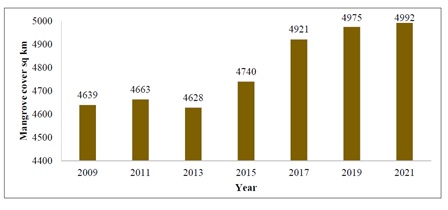Future-proofing for Climate Change and the Environment
DOI:
https://doi.org/10.54741/asejar.2.1.5Keywords:
climate change, environment, green house, river agriculture, wildlife, treesAbstract
The industrialised countries' disproportionately high cumulative emissions of greenhouse gases (GHGs), as well as their high yearly per capita emissions of GHGs, are mostly to blame for climate change. Although contributing only 4% of the total worldwide emissions (from 1850 to 2019) and maintaining significantly lower per capita emissions than the global average, India is one of the most vulnerable regions due to the problem's global nature. Even though India isn't as much to blame for the huge stock of emissions, it has shown that it is a leader in the world by taking many steps and committing to a growth path with low emissions and a goal of net-zero emissions by 2070.
India has combined its ambitious climate action goals with its development objectives, whether it be through increased solar power capacity (installed), higher energy saving targets announced in PAT cycle-VII, or improved green cover made possible by the Green India Mission, among other focused government initiatives. India presently has 75 Ramsar sites for wetlands as part of its commitment to preserving ecosystems, in addition to several legal and promotional initiatives to save and conserve mangroves. With Namami Gange and the National River Conservation Plan (NRCP), people are working all the time to protect rivers and bring them back to life.
Downloads
References
Byravan S., & Rajan S. (2012). An evaluation of India’s national action plan on climate change. Center for Development Finance (CDF), IFMR, and Humanities and Social Sciences, IIT Madras.
Rattani V. (2018). Coping with climate change – An analysis of India’s national action plan on climate change. Center for Science and Environment.
https://www.nber.org/papers/w30265.
Daniel Yergin. (2022). Bumps in the energy transition. Finance & Development, International Monetary Fund. Available at: https:// www.imf.org/en/Publications/fandd/issues/2022/12/bumps-in-the-energy-transition-yergin.
https://fsi.nic.in/forest-report-2021-details.
Pujarini Samal, Jyoti Srivastava, S.R. Singarasubramanian, Pooja Nitin Saraf, & Bipin Charles. (2022). Ensemble modeling approach to predict the past and future climate suitability for two mangrove species along the coastal wetlands of peninsular India, Ecological Informatics, 72.
NITI Aayog. (2019). SDG India index & dashboard 2019-20. Available at: https://www.niti.gov.in/sites/ default/files/SDG-India-Index-2.0_27-Dec.pdf
International Renewable Energy Agency (IRENA). (2020). Green hydrogen cost reduction: Scaling up electrolysers to meet the 1.50C Cli¬mate Goal.
Gap between resource availability, requirement pose challenge in NDC implementation: Eco survey. (2021, Jan 29). Economic Times.
Pandey K. (2022). State of India’s environment in figures: India recorded 280 heat wave days across 16 states in 2022 — most in decade. Down To Earth.

Published
How to Cite
Issue
Section
ARK
License
Copyright (c) 2023 Dr. Alka Vyas, Dr. Rakhi Dwivedi

This work is licensed under a Creative Commons Attribution 4.0 International License.
Research Articles in 'Applied Science and Engineering Journal for Advanced Research' are Open Access articles published under the Creative Commons CC BY License Creative Commons Attribution 4.0 International License http://creativecommons.org/licenses/by/4.0/. This license allows you to share – copy and redistribute the material in any medium or format. Adapt – remix, transform, and build upon the material for any purpose, even commercially.










